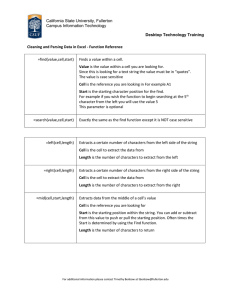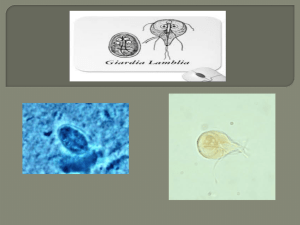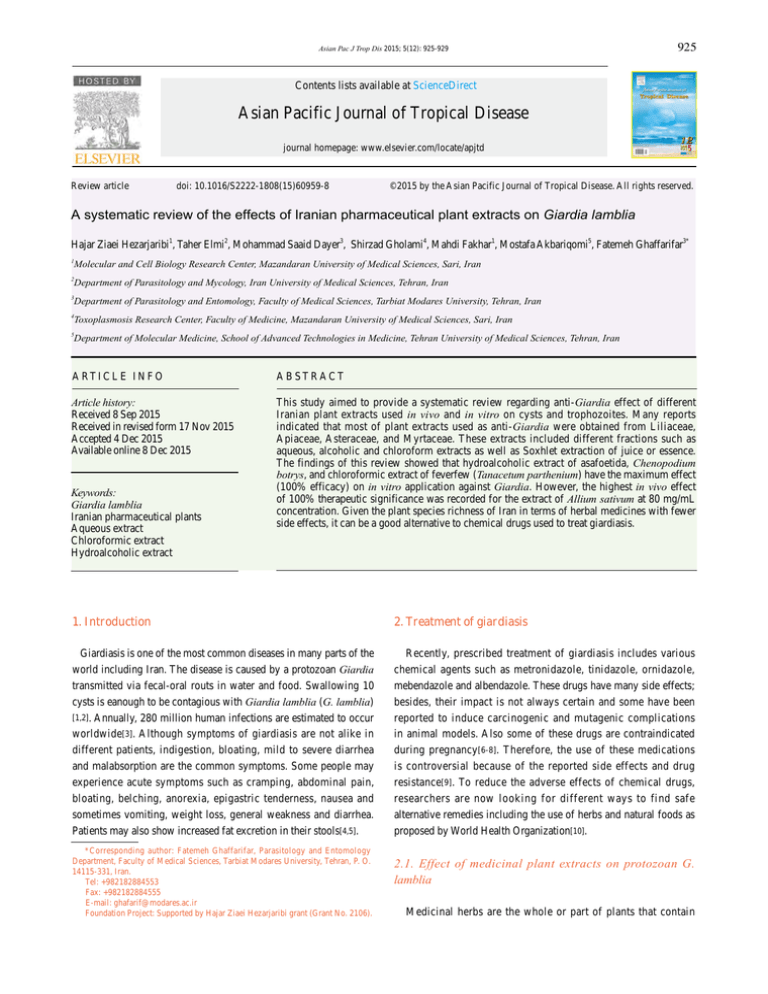
Asian Pac J Trop Dis 2015; 5(12): 925-929
925
Contents lists available at ScienceDirect
Asian Pacific Journal of Tropical Disease
journal homepage: www.elsevier.com/locate/apjtd
Review article
doi: 10.1016/S2222-1808(15)60959-8
©2015 by the Asian Pacific Journal of Tropical Disease. All rights reserved.
A systematic review of the effects of Iranian pharmaceutical plant extracts on Giardia lamblia
Hajar Ziaei Hezarjaribi1, Taher Elmi2, Mohammad Saaid Dayer3, Shirzad Gholami4, Mahdi Fakhar1, Mostafa Akbariqomi5, Fatemeh Ghaffarifar3*
1
Molecular and Cell Biology Research Center, Mazandaran University of Medical Sciences, Sari, Iran
2
Department of Parasitology and Mycology, Iran University of Medical Sciences, Tehran, Iran
3
Department of Parasitology and Entomology, Faculty of Medical Sciences, Tarbiat Modares University, Tehran, Iran
4
Toxoplasmosis Research Center, Faculty of Medicine, Mazandaran University of Medical Sciences, Sari, Iran
5
Department of Molecular Medicine, School of Advanced Technologies in Medicine, Tehran University of Medical Sciences, Tehran, Iran
A RT I C L E I N F O
A B S T R AC T
Article history:
Received 8 Sep 2015
Received in revised form 17 Nov 2015
Accepted 4 Dec 2015
Available online 8 Dec 2015
This study aimed to provide a systematic review regarding anti-Giardia effect of different
Iranian plant extracts used in vivo and in vitro on cysts and trophozoites. Many reports
indicated that most of plant extracts used as anti-Giardia were obtained from Liliaceae,
Apiaceae, Asteraceae, and Myrtaceae. These extracts included different fractions such as
aqueous, alcoholic and chloroform extracts as well as Soxhlet extraction of juice or essence.
The findings of this review showed that hydroalcoholic extract of asafoetida, Chenopodium
botrys, and chloroformic extract of feverfew (Tanacetum parthenium) have the maximum effect
(100% efficacy) on in vitro application against Giardia. However, the highest in vivo effect
of 100% therapeutic significance was recorded for the extract of Allium sativum at 80 mg/mL
concentration. Given the plant species richness of Iran in terms of herbal medicines with fewer
side effects, it can be a good alternative to chemical drugs used to treat giardiasis.
Keywords:
Giardia lamblia
Iranian pharmaceutical plants
Aqueous extract
Chloroformic extract
Hydroalcoholic extract
1. Introduction
2. Treatment of giardiasis
Giardiasis is one of the most common diseases in many parts of the
world including Iran. The disease is caused by a protozoan Giardia
transmitted via fecal-oral routs in water and food. Swallowing 10
cysts is eanough to be contagious with Giardia lamblia (G. lamblia)
[1,2]. Annually, 280 million human infections are estimated to occur
worldwide[3]. Although symptoms of giardiasis are not alike in
different patients, indigestion, bloating, mild to severe diarrhea
and malabsorption are the common symptoms. Some people may
experience acute symptoms such as cramping, abdominal pain,
bloating, belching, anorexia, epigastric tenderness, nausea and
sometimes vomiting, weight loss, general weakness and diarrhea.
Patients may also show increased fat excretion in their stools[4,5].
Recently, prescribed treatment of giardiasis includes various
chemical agents such as metronidazole, tinidazole, ornidazole,
mebendazole and albendazole. These drugs have many side effects;
besides, their impact is not always certain and some have been
reported to induce carcinogenic and mutagenic complications
in animal models. Also some of these drugs are contraindicated
during pregnancy[6-8]. Therefore, the use of these medications
is controversial because of the reported side effects and drug
resistance[9]. To reduce the adverse effects of chemical drugs,
researchers are now looking for different ways to find safe
alternative remedies including the use of herbs and natural foods as
proposed by World Health Organization[10].
*Corresponding author: Fatemeh Ghaffarifar, Parasitology and Entomology
Department, Faculty of Medical Sciences, Tarbiat Modares University, Tehran, P. O.
14115-331, Iran.
Tel: +982182884553
Fax: +982182884555
E-mail: ghafarif@modares.ac.ir
Foundation Project: Supported by Hajar Ziaei Hezarjaribi grant (Grant No. 2106).
2.1. Effect of medicinal plant extracts on protozoan G.
lamblia
Medicinal herbs are the whole or part of plants that contain
926
Hajar Ziaei Hezarjaribi et al./Asian Pac J Trop Dis 2015; 5(12): 925-929
effective substances which constitute less than 1% dry weight
2.1.4. Sambucus ebulus (S. ebulus)
and are of medicinal properties[11]. Researchers have recorded
S. ebulus belongs to the plant family Caprifoliaceae and its
significant effects of various medicinal plant extracts on many
elderberry stems, leaves, roots and fruits are used in the treatment
parasites such as Giardia. Giardiasis is one of the most common
of various diseases[20]. A study showed anti-inflammatory effects of
parasitic infections of early ages that can cause growth retardation
S. ebulus on inflammation caused by burns, eczema and edema[21].
in children[12]. Some of medicinal plants reported as effective drugs
Antiparasitic and antibacterial effects of elderberry have also been
with fewer side effects against giardiasis are as follows.
documented[22]. In an in vitro study, Rahimi-Esboei et al. have
shown that the plant extract has good effect on giardiasis[20].
2.1.1. Carum copticum (C. copticum)
The plant C. copticum belongs to Apiaceae family. The essential
2.1.5. Asafoetida
oils and compounds such as thymol, terpinene and flandern are
Ferula asafoetida is an important medicinal plant of the family
important ingredients present mainly in seeds which are also
Apiaceae. Resin obtained from this plant is used in traditional
the richest part of oil in the plant. Carum extracts have been
medicine to treat many diseases particularly parasitic diseases[23].
demonstrated to have analgesic, antinausea, antiflatulent, and
There is evidence on carminative and analgesic effects of the plant
antiparasitic effects[13]. Several studies showed that the plant was
extracts. Kiasalari et al. reported that alcoholic extract of this
effective against Gram-positive and Gram-negative bacteria and
resinous plant was an effective herbal medicine in the treatment of
prevents the growth of several fungi[14]. A study on antigiardiasis
epilepsy and seizures in mice[24]. Its aqueous extracts also showed in
effects of this plant revealed that the plant extract has the ability to
vitro anti-Trichomonas activity[25]. Studies were undertaken to examine
destroy all Giardia cysts in vitro at a concentration of 100 mg/mL[13].
the effect of aqueous and alcoholic extracts of this plant on Giardia
cysts, and the results showed that the alcoholic extract was more
2.1.2. Tanacetum parthenium (T. parthenium)
effective than the aqueous extract in destroying Giardia cysts in 5 h[23].
T. parthenium belongs to the family Asteraceae, a bunch of
flowering plants, which produce yellow, white and sometimes
2.1.6. Artemisia annua (A. annua)
purple flowers. The plant prefers more rough and sandy soil and
A. annua is a flowering plant from the family Asteraceae.
grows near the edge of crop fields. This herb is one of the most
The plant contains artemisinin, a sesquiterpene lactone[26]. This
effective drugs for the treatment of allergic asthma[11].
chemical has an internal peroxide bridge which appears to be
T. parthenium extract has been successfully used in the
indispensable for the chemotherapeutic activity, hence it was used
treatment of abdominal pain, flatulence, nervous headaches,
as an antimalarial drug in the tropics[27]. In vitro studies have shown
migraine, colitis and nerve compression[15]. The flowers contain
that artemisinin can kill parasites and bacteria and reduce human
a large amount of terpene lactones as well as parthenolide of
malaria mortality by 50% as compared to standard anti-malaria
which antiparasitic effects have been documented[11]. In vitro
drug quinoline[11]. This herb has, also, anti-cancer properties and is
studies showed that crude extracts of T. parthenium inhibited
of selective toxicity to breast cancer cells[28]. Hydroalcoholic and
the growth of epimastigote of Trypanosoma cruzi[16]. In another
chloroform extracts of this herb indicated antigiardiasis activity in
study, chloroform extract of T. parthenium was showed to be more
vitro at concentration of 100 mg/mL[26].
effective on Giardia cyst than hydroalcoholic extract[11]. The plant
extract was suggested to be an herbal treatment for giardiasis in
Balb/c mice[8].
2.1.7. Eucalyptus globules (E. globules)
Being a member of the Myrtaceae family, this plant contains
cineole as an active ingredient in its leaves. Cineole of Eucalyptus
2.1.3. Zataria multiflora (Z. multiflora)
This plant is a member of Lamiaceae family of which
has anti-cancer, anti-inflammatory and anti-pain properties [29].
Several studies showed that Eucalyptus extract has, also, anti-fungal
antibacterial, antiparasitic and antifungal actions have been
and anti-malarial activities[30]. Some in vitro studies has proved the
proven in various studies [17,18]. Thymol and carvacrol are the
effectiveness of Eucalyptus against giardiasis[29].
main antibacterial constituents of essential oil of the plant[17]. A
recent study has demonstrated the effect of Z. multiflora extract on
the growth of Staphylococcus aureus[18]. Keramati et al. reported
2.1.8. Heracleum glabrescens (H. glabrescens) and Satureja
hortensis (S. hortensis)
that extracts of leaves and flowering shoots of the plant were
H. glabrescens is a plant from family Apiaceae (Umbelliferae)
effective in treating dimethylbenzanthracene induced carcinoma in
and S. hortensis belongs to Lamiaceae (Labiatae). The mint H.
prostate of the desert mouse[19]. Farsangi found that Z. multiflora
glabrescens contains resin and anethole and therefore has anti-
extract caused higher mortality of G. lamblia cysts (91.1%)
bacterial and antiparasitic activities. Also, leaf extract of S. hortensis
than metronidazole (89%), and was recommended as a suitable
herb includes thymol and carvacrol in its composition which are of
alternative drug for giardiasis[17].
antibacterial properties[31]. Safarnejad et al. showed that alcoholic
927
Hajar Ziaei Hezarjaribi et al./Asian Pac J Trop Dis 2015; 5(12): 925-929
extracts of S. hortensis and H. glabrescens caused 84.3% and 44%
mortality of Giardia cysts, respectively[29].
2.1.9. Chenopodium botrys (C. botrys)
Belonging to the family Amaranthaceae, C. botrys was used as
antiparasitic drug in traditional medicine. Ziaei et al. provided
evidence on cytotoxic effect of aqueous extract of C. botrys on
Trichomonas vaginalis trophozoite at concentrations equal to 0.1%
and 0.01% in 1 to 4 h[32]. However, examing fruit and seed extracts
of C. botrys, Rezaeemanesh et al. showed that the extracts have antiGiardia activity[33].
2.1.10. Allium
The most important plants in the genus Allium in the family
Liliaceae are garlic [Allium sativum (A. sativum)], onion [Allium
cepa, Allium paradoxum (A. paradoxum)], shallots (Allium
ascalonicum)[34]. It has been reported that the administration of
sulfoxide amino acids found in garlic and onion improved the
diabetic conditions such as glucose tolerance, weight loss and
depletion of liver glycogen. In other studies, oral administration of
garlic extract increased gastric acid and pepsin hypersecretion in
animals and humans[11,35].
Azadbakht et al. found the liquid extracts of onion, garlic, and
shallot to be effective in vitro on Giardia cysts[34]. The highest
mortality of Girdia cysts was recorded for all extracts at 24 °C after 3
h incubation[33]. In vivo studies revealed that ethanolic extract of A.
paradoxum was more effective on Giardia cysts than the chloroform
extract at a concentration equal to 100 mg/mL[11]. Elmi has also
shown that ethanolic extract of A. paradoxum was significantly more
effective than the chloroform extract in the treatment of giardiasis[36].
However, chloroform extract of garlic was of better performance in
the treatment of mice infected with Giardia parasite[36].
Potential teratogenic side effects of metronidazole and other drugs
used to treat giardiasis make it necessary to find alternative drugs;
hence identifing antiparasitic compounds from other sources, such as
herbs, seems essential. Therefore, the present study was intended to
review the anti-giardiasis effects of various medicinal plants studied
in Iran.
2.2. Effect of various plant extracts on Giardia cysts in vitro
Most studies concerning the effect of different plant extracts on
Giardia parasite were carried out under in vitro conditions in Iran.
And 10 out of 26 studies used alcoholic fractions for their in vitro
analyses. Evaluating the results of these studies illustrated that only
alcoholic and chloroform extracts were able to destroy Giardia
cysts. In the alcoholic extract, both asafoetida and C. botrys at a
concentration of 20 mg/mL were the most effective to produce 100%
killing effect on G. lamblia cysts. However, chloroform extracts of
A. sativum and T. parthenium at concentrations equal to 8 mg/mL
and 100 mg/mL respectively were able to produce 100% mortality
on Giardia cysts (Table 1).
Among the extracts studied in vitro, the boiled extract of Z.
multiflora has the lowest effect (7%) in destroying cysts (Table 1).
Table 1
Effects of plant extracts on G. lamblia cysts under in vitro condition in Iran.
Scientific name Fractions
EC (mg/mL) Time (h) Drug effects (%)
C. copticum Aqueous
700
3
10.0
Hydroalcoholic
75
1
94.1
Essence
6
1
95.5
T. parthenium Hydroalcoholic
100
3
87.0
Chloroform
100
3
100.0
Z. multiflora Essence
1
91.1
Boiling
1
7.0
Soxhlet
1
13.8
S. ebulus
Alcoholic
100
1
78.0
Asafoetida
Aqueous
20
5
57.2
Alcoholic
20
4
100.0
A. annua
Hydroalcoholic
100
3
94.0
E. globules
Alcoholic
200
1
63.3
H. glabrescens Alcoholic
200
1
44.0
S. hortensis
Alcoholic
200
1
84.3
C. botrys
Aqueous
20
5
66.1
Alcoholic
20
5
100.0
A. sativum
Liquid
3
43.2
Chloroform
8
8
100.0
Allium cepa Liquid
3
40.8
AA
Liquid
3
33.6
A. paradoxum Hydroalcoholic
100
3
97.0
Chloroform
100
3
96.0
Vinegar
Juice
1
3
40.6
Lemon
Juice
1
3
28.3
Vinifera
Juice
1
3
16.2
Organs
Seed
Seed
Seed
Flower
Flower
Dried plant
Dried plant
Dried plant
Fruit
Gum
Gum
Stem, leaf
Leaf
Seed
Leaf
Seed
Seed
Bulb
Bulb
Bulb
Bulb
Leaf
Leaf
Fruit
Fruit
Fruit
Ref.
[13]
[13]
[13]
[11]
[11]
[17]
[17]
[17]
[20]
[23]
[23]
[26]
[29]
[29]
[29]
[32]
[32]
[33]
[37]
[33]
[33]
[11]
[11]
[38]
[38]
[38]
AA: Allium ascalonicum; EC: Effective concentration.
2.3. Study on the effects of different plant extracts on Giardia
cysts in vivo
Because of the difficulties associated with in vivo methods, less
studies have been undertaken to examine the effects of plant extracts
on G. lamblia in animal or human. Major obstacles of in vivo
study are as follows: 1) infecting animals; 2) providing appropriate
conditions for animals; 3) keeping the experimental animal alive
until the end of the study. Nonetheless, some authors have studied the
effects of medicinal plants extracts on G. lamblia parasite in vivo[8,3639].
Safar Harandi et al. indicated that extract of A. sativum was the
most effective in treating Giardia infection in mice at 80 mg/mL in
3 days[37]. Others showed that the extracts of T. parthenium and A.
paradoxum had 92% and 88% therapeutic effect on mice infected with
G. lamblia, showing acceptable results (Table 2)[8,36].
Hydroalcoholic extract of A. paradoxum was of the lowest efficacy
(71%) among the in vivo applied plant extracts (Table 2).
Table 2
Effects of plant extracts on G. lamblia cysts under in vivo condition in Iran.
Scientific name
A. paradoxum
T. parthenium
Fractions
EC (mg/mL) Time (day)
Hydroalcoholic
100
3
Chloroform
100
3
Chloroform
100
3
A. sativum
Chloroform
80
3
DE (%)
71
88
92
100
Organs
Leaf, bulb
Bulb
Flower
Ref.
[36]
[36]
[8]
Bulb
[37]
EC: Effective concentration; DE: Drug effects.
3. Discussion
G. lamblia is one of the most common intestinal parasites in many
parts of the world as well as Iran, particularly in the northern areas
928
Hajar Ziaei Hezarjaribi et al./Asian Pac J Trop Dis 2015; 5(12): 925-929
of Iran[8]. Giardiasis infection varies in different regions of Iran
have different antibacterial constituents, it is recommended to
from 1% to 25%. It has been estimated that about 280 million
ensure the examination of all parts of the medicinal plants. Also,
Giardia infections occur worldwide in humans annually [3] .
significant in vitro results should be fortified with more in vivo
Chemical treatment of the disease by metronidazole, furazolidone,
experiments to pave the way for introduction of more plant-based
and tinidazole drugs has many side effects including carcinogenic
drugs for a better health and safer life.
implications in women and children. Yet, their efficacy is unknown
and their use is contraindicated during pregnancy[2,8].
Conflict of interest statement
In recent years, reports on parasite resistance to the above drugs
have been in rise[9]. Different methods have been suggested to
We declare that we have no conflicts of interest.
eliminate Giardia cyst and trophozoite. One of such methods
suggested by World Health Organization is the use of herbs and
natural
foods[10].
Acknowledgments
In recent years, the use of medicinal herbs has
increased due to their low side effects.
This study is funded by Hajar Ziaei Hezarjaribi grant with Grant
Based on in vivo and in vitro studies, extracts of medicinal plants
No. 2106. The authors wish to thank all colleagues in Parasitology
such as garlic, C. copticum, asafoetida, T. parthenium, and A.
Departments of Tarbiat Modares University and Molecular and
paradoxum showed promising effects in the elimination of Giardia
Cell Biology Research Center of Mazandaran University of
cysts particularly when used in combination as anti-Giardia
Medical Sciences.
complex drug[8,23,33,36].
The diversity of plants used in different studies have shown
References
interesting results. Being member of different plant families, each
herb showed a specified antiparasitic effect. For example, A. annua
(Asteraceae) has shown more anti-giardiasis effect in comparison
[1] Saebi E. [Text book of clinical parasitilogy, protozoal diseasesin Iran].
5th ed. Tehran: Aeeizh; 2011. P. 97-117. Persian.
with E. globules (Myrtaceae) [26,29] . Also, A. sativum extract
[2] Suman MSH, Alam MM, Pun SB, Khair A, Ahmed S, Uchida RY.
(Amaryllidaceae) was more effective than T. parthenium extract
Prevalence of Giardia lamblia infection in children and calves in
(Asteraceae) in treating mice infected with G. lamblia as revealed
Bangladesh. Bangladesh J Vet Med 2011; 9(2): 177-82.
by Safar Harandi et al.[37] and Elmi et al.[8]. However, differences
[3] B avand Z, Gholami Sh, Honary S, Rahimi-Esboei B, Torabi N,
between human and murine strains of Giardia is an important
Barabadi H. In vitro evaluation of the effect of gold nanoparticles on
factor which may affect the results.
It can be drawn from the published studies that in addition
Giardia lamblia cyst. Arak Med Univ J 2013; 16(79): 27-37.
[4] Taherkhani H, Shariati S, Abdolahi N, Roshandel GH. Clinical
to the plant species, the kind of chemical fractions (ethanolic,
manifestations of giardiasis in Iran. J Clin Diagn Res 2009; 3: 1416-8.
aqueous, chloroform) and experimental environments (in vitro
[5] Adam RD. Biology of Giardia lamblia. Clin Microbiol Rev 2001;
and in vivo) play determinant role in the outcomes. For example,
14(3): 447-75.
the hydroalcoholic extracts showed greater anti-Giardia effects
[6] Sarmadian H, Zarrinfar N, Fani A, Mousavi FM, Didgar F, Khaki
compared with aqueous extracts[13]. Also, T. parthenium extract
M, et al. Effect of metronidazole on amount of blood’s lipids of
showed a greater anti-Giardia effect when applied in vitro than in
hyperlipidemia people. Arak Univ Medi Sci J 2008; 11(3): 63-9.
vivo[8,11]. This is because under in vivo conditions micro-organisms
[7] Falagas ME, Walker AM, Jick H, Ruthazer R, Griffith J, Snydman
would be affected by both herbal drugs and animal immune system
DR. Late incidence of cancer after metronidazole use: a matched
simultaneously. Consequently, the results would be more realistic
metronidazole user/nonuser study. Clin Infec Dis 1998; 26(2): 384-8.
under in vivo conditions. We may recommended that the plant
[8] Elmi T, Gholami Sh, Azadbakht M, Ziaie H. [Effect of chloroformic
extracts showing promising antiparasitic effect in test tube should
extract of Tanacetum parthenium in the treatment of Giardia lamblia
be examined under in vivo conditions for therapeutic significance
infection in Balb/c Mice]. J Mazand Univ Med Sci 2014; 24: 157-65.
(where possible).
Persian.
Nowadays, the anti-bacteria properties of various plants such
as Artemisia aucheri, Thymus vulgaris, Salvia officinalis, E.
[9] Rossignol JF. Cryptosporidium and Giardia: treatment options and
prospects for new drugs. Exp Parasitol 2010; 124(1): 45-53.
globules, Matricaria recutita, and Zingiber against Pseudomonas,
[10] World Health Organization. WHO/PAHO informal consultation
Brucella, acute bronchitis, inflammation, diarrhea, and seizures
on intestinal protozoal infections. Geneva: World Health
have been proven[39-41]. Due to the side effects of chemical drugs,
Organization; 1992. [Online] Available from: http://apps.who.int/iris/
more comprehensive studies should be undertaken to examine the
bitstream/10665/60366/1/WHO_CDS_IPI_92.2.pdf [Accessed on 20
medical properties of other native plants of this country. Researches
August, 2015]
should be also directed towards different plant fractions. Since
[11] R ahimi-Esboei B. The in vitro effectiveness of chloroform and
various parts of plants including roots, leaves, stems, and fruits
hydroalcoholic extracts of Artemisia annua, Allium paradoxium
Hajar Ziaei Hezarjaribi et al./Asian Pac J Trop Dis 2015; 5(12): 925-929
929
and Tanacetum parthenium on Giardia lamblia cysts and
[27] B lanke CH, Naisabha GB, Balema MB, Mbaruku GM, Heide L,
trophozoites[Dissertation]. Iran: Mazandaran University of Medical
Muller MS. Herba Artemisia eannuae tea preparation compared
Sciences; 2012, p. 1438.
to sulfadoxine-pyrimethamine in thetreatment of uncomplicated
[12] Al-Mekhlafi MS, Azlin M, Nor Aini U, Shaik A, Sa’iah A, Fatmah
MS, et al. Giardiasis as apredictor of childhood malnutrition in Orang
Asli children in Malaysia. Trans R Soc Trop Med Hyg 2005; 99: 68691.
falciparum malaria in adults: a randomized doubleblindclinical trial.
Trop Doct 2008; 38: 113-6.
[28] Efferth T. Antiplasmodial and antitumor activity of artemisinin-from
bench to bedside. Planta Med 2007; 73: 299-309.
[13] Shahabi S, Ayazi Roozbehani F, Kamalinejad M, Abadi A. [Anti-
[29] S
afarnejad Tameshkel F, Khatami Nejad MR, Nasrollahi A, Rahdari P,
Giardia activity of Carum copticum on Giardia lamblia cysts in vitro].
Gholam Hossein Poor F, Kazemi Afarmejani S, et al. The antimicrobial
Res Med 2008; 32(4): 303-7. Persian.
effect of methanol extracts of Eucalyptus, Satureia hortensis and
[14] Nagulakshmi S, Shankaracharya NB, Naik JP, Rao LJM. Studies on
Heracleum glabrescens on Giardia cysts. Med Lab J 2012; 6(2): 21-6.
chemical and technological aspects of ajowan (Trachyspermum ammi
[30] S attari M, Shahbazi A, Najarpyrayh SH. [Antibacterial effect of
syn. Carum copticum Hiern). J Food Sci Techol 2000; 37: 277-81.
[15] Fereydouni M, Etemadi L, Borook A. Analgesic effect of flower and
leaf extracts of Tanacetum parthenium using formalin test in mice.
Physiol Pharmacol 2002; 5(2): 189-98.
aqueous and alcoholic extracts of eucalyptus on Pseudomonas
aeruginosa]. Modares J Med Sci 1384; 8(1): 19-23. Persian.
[31] S amsam Shariat SH, Moattar F. [Medicinal plants and natural
products]. Isfahan: Mashal Publications; 1990, p. 431-3. Persian.
[16] Izumi E, Morello LG, Ueda-Nakamura T, Yamada-Ogatta SF, Filho
[32] Z iaiye H, Azadbakht M, Abdollahi F, Shabankhani B. Effect of
BP, Cortez DA, et al. Trypanosoma cruzi: antiprotozoal activity of
methanolic extract of Artemizia aucheri Boiss, Zataria multiflora
parthenolide obtained from Tanacetum parthenium (L.) Schultz Bip.
Boiss and Myrtuscommunis L on Trichomonas vaginalis (in vitro). J
(Asteraceae, Compositae) against epimastigote and amastigote forms.
Exp Parasitol 2008; 118: 324-30.
[17] Farsangi M. Killing effect of Zataria multiflora on cysts of Giardia
lamblia in vitro. J Clin Microbiol 2001; 4: 88-95.
[18] Chaleshtori RS, Kopaei MR, Rokni N, Mortezaei S, Chaleshtori AS.
Gorgan Univ Med Sci 2006; 8: 34-8.
[33] Rezaeemanesh M, Shirbazoo Sh, Pouryaghoub N. [In-vitro giardicidal
effects of aqueous and alcoholic extracts of Chenopodium botrys L. on
Giardia lamblia cysts]. J Torbat Heydariyeh Univ Med Sci 2013; 1(1):
21-31. Persian.
Antioxidant activity of Zataria multiflora hydroalcoholic extract and
[34] Azadbakht M, Sajjadi SM, Rostami J. Giardiacidal activity of three
its antibacterial effect on Staphylococcus aureus. J Mazandaran Univ
Allium species on Giardia intestinalis cysts. Iran J Basic Med Sci
Med Sci 2013; 22(1): 88-94.
2003; 3: 184-8.
[19] Keramati K, Sanaie K, Babakhani A, Rakhshan M, Vaezi G, Haeri
[35] Shahrani M, Rafieian M, Shirzad HA, Hashemzadeh Chaleshtori M,
A. Effect of Thymus vulgaris hydro-alcoholic extraction on DMBA
Yousefi H, Khadivi R, et al. Effect of Allium sativum L. extract on
induced prostate cancer in Wistar rat. Res Med 2011; 35(3): 135-40.
acid and pepsin secretion in basal condition and stimulated with vag
[20] Rahimi-Esboei B, Ebrahimzadeh MA, Gholami Sh, Falah-Omrani V.
Anti-giardial activity of Sambucus ebulus. Eur Rev Med Pharmacol
Sci 2013; 17: 2047-50.
[21] E brahimzadeh MA, Mahmoudi M, Salimi E. Antiinflammatory
activity of Sambucus ebulus hexane extracts. Fitoterapia 2006; 77:
146-8.
[22] Ebrahimzadeh MA, Mahmoudi M, Karami M, Saeedi S, Ahmadi AH,
Salimi E. Separation of active and toxic portions in Sambucus ebulus.
Pak J Biol Sci 2007; 10: 4171-3.
[23] R ezaiemanesh MR, Shirbazou Sh. [In-vitro giardicidal effect of
aqueous and alcoholic extracts of asafoetida on Giardia lamblia cyst].
J Birjand Univ Med Sci 2012; 19(1): 22-3. Persian.
stimulate in rat. J Med Plants 2007; 6(24): 28-37.
[36] Elmi T, Gholami SH, Azadbakht M, Rahimi-Osboei B, Geraili Z.
[The effects of hydroalcoholic extract of leaves and onion of Allium
paradoxum on Giardia lamblia in mice]. J Shahrekord Univ Med Sci
2014; 16(5): 13-22. Persian.
[37] S
afar Harandi MM, Dalimi Asl A, Ghaffarifar F. [In vitro and in vivo
effects of garlic (Allium sativum) extract on Giardia lamblia and
Giardia muris]. Hakim Res J 2006; 9(3): 58-64. Persian.
[38] Sadjjadi SM, Rostami J, Azadbakht M. Giardiacidal activity of lemon
juice, vinifer and vinegar on Giardia intestinalis cysts. Southeast
Asian J Trop Med Public Health 2006; 37(Suppl 3): 24-7.
[39] Hashemi A, Shams S, Barati M, Samedani A. Antibacterial effects
[24] Kiasalari Z, Khalili M, Heidari H. Investigation of anti-convulsant
of methanolic extracts of Zataria multiflora, Myrtus communis and
effect of alcoholic Ferula asafoetida gum extract PTZ-induced
Peganum harmala on Pseudomonas aeruginosa producing ESBL.
kindling model in mice. Sci Res J Shahed Univ 2011; 18: 25-32.
Arak Univ Med Sci J 2011; 14: 104-12.
[25] Sarkari B, Tadayon H, Askarian S, Farnia E, Askarian M. In vitro
[40] A bdollahzadeh P, Shapouri R, Nasiri Semnani S, Alizadeh H.
anti-Trichomonas activity of Freul assafoetida and garlic extracts. J
Evaluation of the antibacterial effects of Eucalyptus globulus extracts
Gorgan Uni Med Sci 2009; 11(3): 13-7.
on intramacrophage Brucella melitensis 16M. Arak Univ Med Sci J
[26] R ahimi-Esboei B, Gholami Sh, Azadbakht M, Ziaei H. Effect of
hydroalcholic extract of Artemisia annua on cysts of Giardia lamblia
in in vitro. J Mazandaran Univ Med Sci 2012; 22(90): 72-80.
2012; 14(7): 55-63.
[41] Fleming T. PDR for herbal medicines. 2nd ed. Montvale: Medical
Economics Company; 2000, p. 461-2.

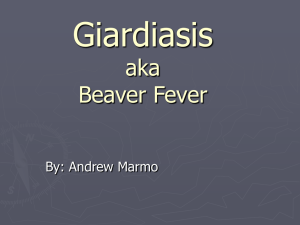
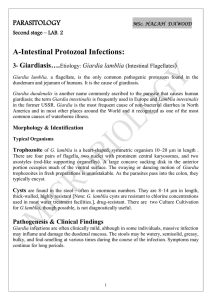
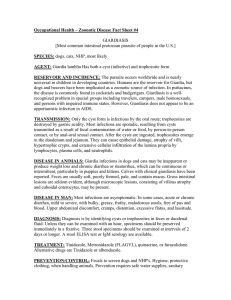
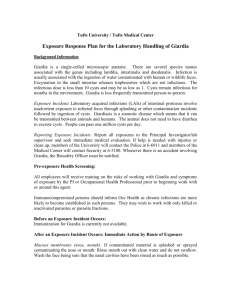
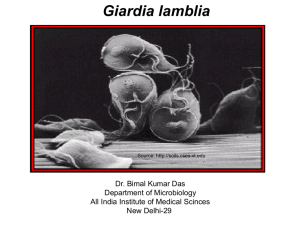
![Literature and Society [DOCX 15.54KB]](http://s2.studylib.net/store/data/015093858_1-779d97e110763e279b613237d6ea7b53-300x300.png)
